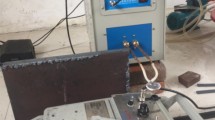Abstract
Pipe bending by high-frequency local induction heating is an advanced technique used to bend pipes having a small bending radius and a large diameter. Although pipe bending is a widely used engineering process, the optimum process parameters are decided on the basis of a trial and error method by highly experienced field engineers. Hence, it is necessary to develop an integrated methodology for the optimum design of the pipe bending process. During hot-pipe bending using induction heating, the thickness of the outer wall of the pipe decreases because of tensile stress, but the thickness is not allowed to decrease by more than 12.5%. The use of the DOE method and a dynamic reverse moment is proposed for maintaining the thickness reduction ratio to within 12.5%, when D/t is high. The results of the proposed approach are found to be in good agreement with those of FEA.
Similar content being viewed by others
Abbreviations
- D :
-
outer diameter of pipe (mm)
- M b :
-
bending moment (kN · m)
- M c :
-
reverse moment (kN · m)
- R :
-
bending radius (mm)
- r :
-
pipe radius (mm)
- r m :
-
average radius of pipe (mm)
- t :
-
pipe thickness (mm)
- t 0 :
-
initial thickness of pipe (mm)
- β :
-
angle of neutral axis (°)
- ΔR :
-
distance between neutral axis and x-axis
- ρ :
-
radius of curvature
References
Hu, Z. and Li, J. Q., “Computer simulation of pipe-bending processes with small bending radius using local induction heating,” J. Mater. Process. Technol., Vol. 91, No. 1, pp. 75–79, 1999.
OKeefe, W., “Inductive bending machine seeks to reduce number of welds in nuclear piping system,” Power, Vol. 121, No. 12, pp. 74–75, 1977.
Hu, Z., “Elasto-plastic solutions for spring-back angle of pipe bending using local induction heating,” J. Mater. Process. Technol., Vol. 102, No. 1–3, pp. 103–108, 2000.
Kuriyama, S. and Aida, T., “Theoretical analysis of bending of tube having uniform distribution of temperature by high frequency induction heating,” Proc. of the 4th Adv. Technol. of Plasticity, pp. 464–469, 1993.
Seong, D. Y., Jung, C. G., Yang, D. Y. and Chung, W. J., “Efficient prediction of local failures for metallic sandwich plates with pyramidal truss cores during the bending processes,” Int. J. Precis. Eng. Manuf., Vol. 12, No. 3, pp. 491–503, 2011.
Wang, Z. and Hu, Z., “Theory of pipe-bending to a small bend radius using induction heating,” J. Mater. Process. Technol., Vol. 21, No. 3, pp. 275–284, 1990.
Ryu, K. H., Lee, D. J., Kim, D. J., Kim, B. M. and Kim, K. H., “Process Design of the Hot Pipe Bending Process Using High Frequency Induction Heating,” J. KSPE, Vol. 18, No. 9, pp. 110–121, 2001.
Kim, E. S., Lee, J. M. and Kim, B. M., “The Shape Optimization of Washing Machine Shaft for High-Speed Rotation through Analysis of Static and Dynamic Characteristics,” J. KSPE, Vol. 25, No. 5, pp. 132–139, 2008.
Baek, S. Y., Kwon, J. W. and Lee, K. D., “Effects of Blank Design Factors on Stretch Flange Forming of the Tailored Blank Using Taguchi Method,” Trans. Mater. Process, Vol. 9, No. 4, pp. 339–347, 2000.
Author information
Authors and Affiliations
Corresponding author
Rights and permissions
About this article
Cite this article
Lee, HW., Bae, JH., Kim, MS. et al. Optimum design of pipe bending based on high-frequency induction heating using dynamic reverse moment. Int. J. Precis. Eng. Manuf. 12, 1051–1058 (2011). https://doi.org/10.1007/s12541-011-0140-6
Received:
Accepted:
Published:
Issue Date:
DOI: https://doi.org/10.1007/s12541-011-0140-6




